Parrot Brains and Our Own
Air Date: Week of May 2, 2025
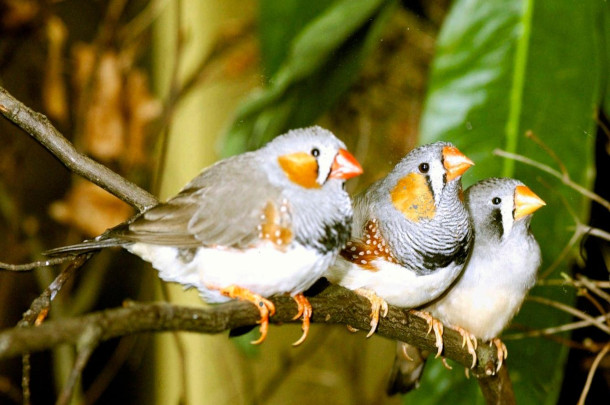
Dr. Long began his research with zebra finches since the males learn their father’s song perfectly in order to court females. (Photo: Ayacop, Accelerated Growth following Poor Early Nutrition Impairs Later Learning, Wikimedia Commons, CC BY 2.5)
Parakeets have astounding vocal abilities and are able to mimic as many as 1700 human words. And their brains may provide insight into how we humans talk. In a recent study, researchers found human-like neural activity during vocalization. Dr. Michael Long led the study and joins Host Paloma Beltran to share how this research may help shed light on communication disorders in humans such as autism.
Transcript
DOERING: It’s Living on Earth, I’m Jenni Doering
BELTRAN: And I’m Paloma Beltran.
Parakeets have astounding vocal abilities. They can mimic sound effects and human speech, like when we ask Siri about something.
PARAKEET TALKING: Hey Siri, tell me about chicken. Hey Siri, Hey Bird, Hey Siri, tell me about chicken…
BELTRAN: They can do this, thanks to their brains. Though “bird brained” tends to be an insult, the brains of parakeets might hold a key to unlocking how human speech works. In a recent study published in Nature, scientists were able to match specific vocalizations to individual neural pathways in the birds’ brains. The researchers hope that their work will teach us more about communication disorders including autism, which impacts around 1 in 45 American adults and 1 in 31 American children. Here to explain is lead researcher Dr. Michael Long, Professor of Neuroscience and Physiology at the NYU Grossman School of Medicine who led the study alongside Zetian Yang. Hi Dr. Long and welcome to the show!
LONG: Thank you. It's great to be here.
BELTRAN: So, we're talking to you about recent research with parakeets, but I understand that your earlier work was primarily with zebra finches. What was working with the finches like, and what did you learn from them?
LONG: Zebra finches are amazing little animals. What they're amazing at is learning through vocal imitation. And so in that species only the male sings. They listen to their father, and they memorize that song. And then over the next months, they practice all day long to try and sound like dad and and they get better and better. And ultimately, when they're about four months old, they have a very good copy of dad's song, and they use that in a courtship setting, so they sing that to the female immediately before mating.
BELTRAN: Oh, so like father, like son.
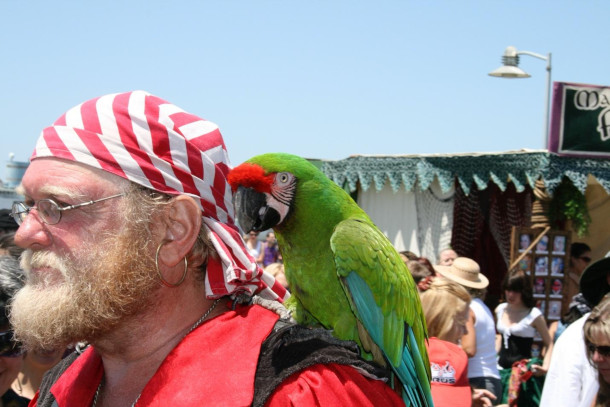
Popular imagination of a talking bird might feature a large parrot on a pirate’s shoulder, but parakeets are actually the masters of vocal imitation in the bird kingdom. (Photo: Chris from Th' L.G., USA, Wikimedia Commons, CC BY-SA 2.0)
LONG: Like father, like son, exactly. And that process of learning is something that actually has deep importance for understanding how the brain works. And so there's first of all, a really exclusive club of animals that can learn through vocal imitation. And so the fact that they can do this is an amazing thing. Monkeys can't, for example, and the process of learning has taught us what it means to take up a new complex skill. So if you imagine picking up a golf club and having to do something as daunting as hit a golf ball closer to the hole than it is right now, it's a tough thing, right? And you have to orchestrate many different muscles, and the bird has the same challenge. How do you take all of these vocal muscles that make that sound and actually get it just perfect so that the female will say, "Ah, that's a good song." And you move on from there.
BELTRAN: You know so we've all seen those pirate movies where the parrot on the captain's shoulder is saying, you know, "Polly want a cracker." But you were working with budgerigars, birds many of our listeners probably know us parakeets. How close is that image of a parrot on a pirate's shoulder to a parakeet's speaking ability?
LONG: You can call them budgie for short, but budgerigar, yeah, and you can also call them the parakeet. They're the same thing, and they're a parrot species. The reason why I had been somewhat intimidated by the parrot, broadly speaking, is that this little zebra finch can do this amazing vocal imitation, but the song itself is about a second long. It takes a couple of months to learn one second. But the budgerigar is something that is incredibly flexible, and so in looking into this, the animal that has set the record for the most human words copied is actually the budgerigar, out of all the parrots, out of all the animals that exist. There was an animal in the early 90s called Puck that could actually speak 1700 identifiable words.
BELTRAN: Wow.
LONG: And so this is something that is amazing to me. How do you get a brain that can do that, that can gather different acoustic objects in its environment and turn that into something that they can fluently say to their partners? And if you look at them, they are in Australia in packs of 1000s, all chatting all day long. It's amazing. And so we thought this is going to be a very tough go. If it's taken us 20 years to try and get to how a zebra finch does its one second long song, how are we going to get to such an amazing vocal ability of this parrot, and how the brain does what it does there?
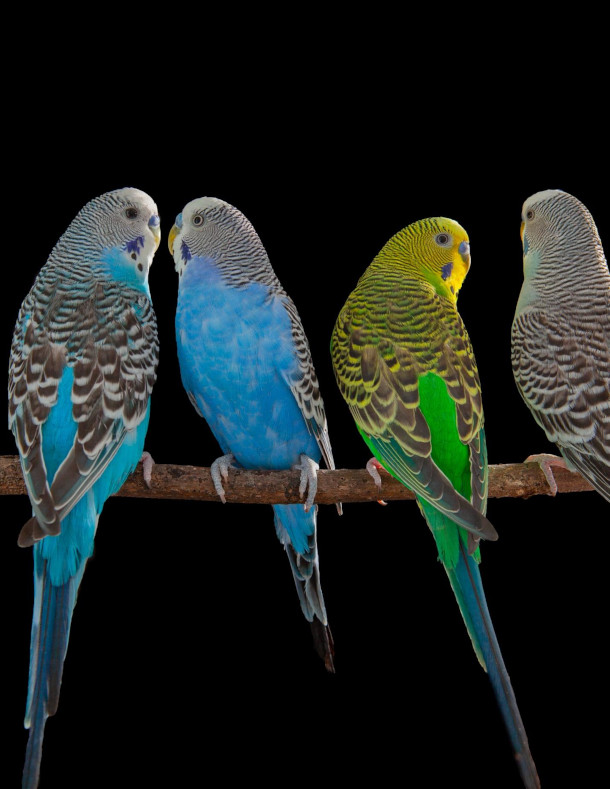
A recent study mapped out the neuroscience of how parakeets imitate sounds they hear in their environment, down to the individual neuron. (Photo: Christopher Auger-Dominguez)
BELTRAN: How were you able to learn how parakeet brains allow them to speak?
LONG: So in our laboratory, we've been really fascinated by human speech. And I think the reason there is, I think if we lose our ability to vocalize, it can really be devastating. I've personally have had relatives that have been affected by autism, by stroke, by things where they're actually robbed of their ability to fluently speak. So it's something I'm really fascinated by, and we do a lot of recordings in people, trying to understand how human brains work. But a human brain has almost 100 billion neurons, and it's really complex. Language is something that is thought to be really unique to humans. How do we get some kind of way in to understand the basic principles for how this works, if there isn't really a good animal model for that? And so what we've decided to do is say, "Let's take a step back. And language is a multi-faceted thing, and different animals have different specialties and different aspects of what they can do." One example is a Costa Rican rodent called the singing mouse, and we could look at their vocalizations with each other. They don't learn what they're singing, but what they do is actually use it in these kind of conversational exchanges with other rodents. So you can see them going back and forth as they're trying to negotiate space within the lab. They do this to talk about territory. This is my home range. Zebra finches learn their song. And so what we wanted to do with the budgerigar is to say, how do you take something that's so flexible, that's so vast and so intimidatingly rich, this ability to pick up words, to pick up all these environmental sounds. And so my naive question walking in is, is their brain going to be processing this information in a way that looks human like or zebra finch like? When we did our recordings, our first ever functional recordings in the brains of these parrots, what we found was something that was distinctly human like. So the way that this works, even though the kind of architecture of the brain is avian in nature, right, the dynamics that allow them to create these sounds was something that looked a lot like the kind of recordings that were made in humans in intercranial settings over the past many years. And I'll give you an example.
There are brain cells in the parrot's brain that are active when the bird speaks sounds that are consonant-like, others that are active during vowel sounds, others that are active during high and low tones. And we do see something that looks just like this in the human brain.
So in this sense, we've uncovered an animal that uses that same strategy of a very simple kind of set of cells that allows us to in combination form words and how that process breaks down, is something that I think can give us a real clear view into communication disorders.
BELTRAN: And how were you able to map out those vowel sounds? What technology did you use for this study?
LONG: There were many things that had to happen here. So one thing is, it don't mean a thing if you can't have them sing. And so we had to build a special cage that allowed them to feel comfortable enough to produce their song, and so we built this kind of social cage. We can do brain mapping of a single bird, but then give them access to many birds that they can chat with. You know, these birds can't be by themselves. They're incredibly social. Our veterinarians won't let us keep them by themselves, and we would never want to do that kind of thing. They're constantly chatting societies of other birds. This is what they're evolved to do. And so number one was working with a really amazing cage company called Corners Limited in Kalamazoo, Michigan. And they made for us a kind of social cage in which there was a compartment with a bunch of birds hanging out that this bird could talk to, and another compartment that could safely allow us to record from that bird's brain. Often, if we put two in the same compartment, then you'll see them starting to interfere with our recording apparatus, and all of that. A second innovation is a small probe that can go into the brain that's very lightweight. We want this bird to be able to carry it comfortably. The brain has no pain sensors, so this is something that is fine, and we can also remove that probe when we're done. And the bird can be just fine to go about what it does. It's an incredibly thin, small probe that goes directly into this area of the brain and allows us to have single neuron resolution, to pick up about 100 simultaneous cells and really map this out for the first time. It's the first time any neurons have been recorded in an awake parrot species of any type. And we look in and we see this human-like map. It was a really thrilling moment for us.
BELTRAN: Dr. Long, why study parakeets to better understand human brains?

Communication disorders impact around 15% of Americans. Michael J. Fox, who has Parkinson’s disease, is a famous example. (Photo: Chuck Kennedy (Pete for America), Wikimedia Commons, public domain)
LONG: I think it's because of their incredible vocal abilities. They mimic a wide range of sounds from the environment. Even our animal caretaker said that when she was squirting water into their dishes, they do a fantastic impression of just that sound itself, you know. So everything that they hear they can grab, almost like taking shiny objects and bringing it to their nest. They do this acoustically. The ability to pick up all of these different vocalizations really on the fly is something that is exciting to me. It doesn't take months and months to learn a single thing. They're very astute, and they can pick things up very quickly. We're working now with a team at Stanford to try and understand how to speak budgerigar. And so this is something I think is really exciting. And we can basically put a head-mounted camera on these birds, and we can see what they see as they're making these different sounds. And if we can then relate what they're seeing to the sounds that they're making, we can start to see how they construct sentences, and how they could potentially convey information in a meaningful way from one animal to the next. And this is something we're really excited about.
BELTRAN: Is the hope that we will eventually be able to communicate with these birds with language?
LONG: Well, I think the hope is there's this notion of human exceptionalism, where language is something that really is something that only we can do. So I think the idea of expanding beyond what we can do, and more than that, really creating a model for how language works in a much simpler brain that gives us some fighting chance of fixing language when it breaks.
About 15% of our population suffers from a communication disorder, and this is anything from aphasia following a stroke, neurodegenerative disorders like Parkinson's disease and age-related dementia, and neurodevelopmental conditions like autism. And I think because of this similar vocal capacity, the budgerigar brings renewed hope for understanding and allows us to maybe give their voice back to people who've lost it. That's something that would be really meaningful for me.
Video courtesy of Dr. Michael Long
BELTRAN: You know, you mentioned autism, and I know that chimpanzees and other great apes don't have the same vocal ability as parrots, but their brains and social lives are much more similar to ours. How could we study something like autism in a bird when their social lives are even more different from ours than our great ape cousins?
LONG: Right, so each animal model, we value it for its perspective that it gives us to such a difficult, multifaceted thing, like language. I would argue the first attempt we're going to take to try and look at autism will come from those singing mice that I mentioned before. We're actually creating an autism model using gene editing in those singing mice. So the idea there is Shank3 is an autism risk gene. And we're using gene editing to try and knock down that gene to ask how that affects communication, and how that affects how the brain of these animals is engaged during this kind of social exchanges. And our very first litter was born two weeks ago. So we'll find out where things are in the very near future. Hopefully we'll talk again and tell you all about it.
BELTRAN: And what are the next steps for this research?
LONG: I think the two major next steps, at least in my view, number one, you know, what are they saying? We want to find out, are their sounds related to specific actions or objects in their environment, and how do they actually express that to another bird. And also, I think, who's playing this keyboard? And so, the idea of just such a simple motor representation of different vocal sounds, now we have to find out how that's exploited by the bird in order to flexibly make whatever sounds they want to make. They're easy to state questions, but they're really tough to get a hand on, and we're making a good run at it.
BELTRAN: Michael Long is professor of neuroscience and physiology at the NYU Grossman School of Medicine. Michael, thank you so much for joining us.
LONG: Thank you. This was fantastic.
Links
Living on Earth wants to hear from you!
Living on Earth
62 Calef Highway, Suite 212
Lee, NH 03861
Telephone: 617-287-4121
E-mail: comments@loe.org
Newsletter [Click here]
Donate to Living on Earth!
Living on Earth is an independent media program and relies entirely on contributions from listeners and institutions supporting public service. Please donate now to preserve an independent environmental voice.
NewsletterLiving on Earth offers a weekly delivery of the show's rundown to your mailbox. Sign up for our newsletter today!
 Sailors For The Sea: Be the change you want to sea.
Sailors For The Sea: Be the change you want to sea.
 The Grantham Foundation for the Protection of the Environment: Committed to protecting and improving the health of the global environment.
The Grantham Foundation for the Protection of the Environment: Committed to protecting and improving the health of the global environment.
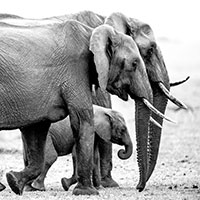 Contribute to Living on Earth and receive, as our gift to you, an archival print of one of Mark Seth Lender's extraordinary wildlife photographs. Follow the link to see Mark's current collection of photographs.
Contribute to Living on Earth and receive, as our gift to you, an archival print of one of Mark Seth Lender's extraordinary wildlife photographs. Follow the link to see Mark's current collection of photographs.
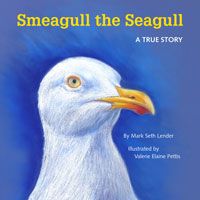 Buy a signed copy of Mark Seth Lender's book Smeagull the Seagull & support Living on Earth
Buy a signed copy of Mark Seth Lender's book Smeagull the Seagull & support Living on Earth

